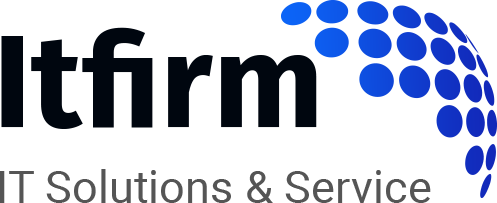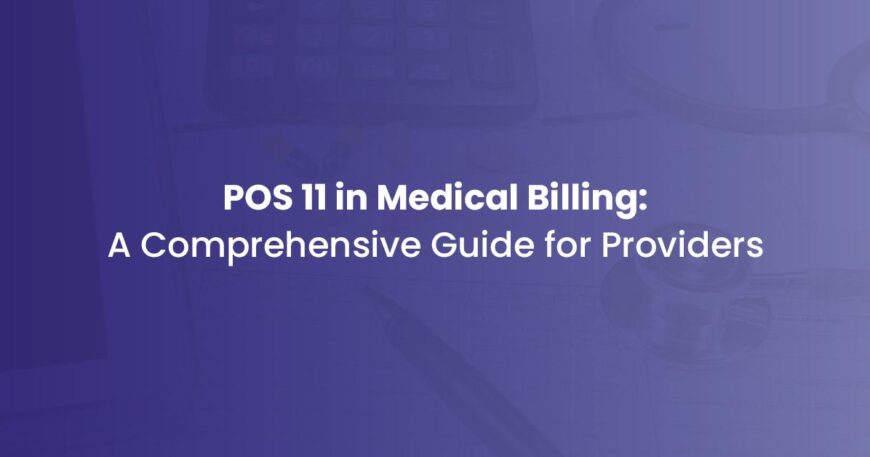You see, when doctors and other healthcare providers deliver care, they do it in settings like hospitals, private practices, clinics, or medical offices. These are smaller, community-focused places, not big government or corporate entities. And in billing codes, these settings are referred to as the “place of service”, or POS.
For example, POS 11 means a doctor’s office. So when your doctor sends a bill after your check-up, it will say POS 11 to show where you were seen.
In this guide, we’ll explore POS 11 in depth. We’ll look at how it’s used in billing, the role it plays in ensuring proper payment, and best practices for its use.
POS Codes in Medical Billing
The Centers for Medicare & Medicaid Services (CMS) assigns specific codes to each place where the physician provided the treatments to their patients. These codes are called “POS Codes”.
POS codes are two-digit numbers used to specify the location where services were provided. These codes help insurance companies determine the appropriate reimbursement rates for the services rendered.
POS Codes are categorized as:
- Facility POS Codes
- Non Facility POS Codes
➜ Facility POS Codes
When patients receive care in facilities like hospitals, nursing homes or skilled nursing facilities, special codes are used to identify the services provided – these are known as Facility POS codes.
You see, facilities need a way to accurately track the care patients receive for proper record-keeping and billing purposes. That’s where Facility POS codes come in handy.
Facility POS codes include:
- Inpatient Hospital (21)
- Outpatient Hospital (22)
- Emergency Room-Hospital (23)
- Urgent Care Facility (20)
- Skilled Nursing Facility (31)
- Hospice facility (32)
- Ambulatory Surgical Center (24)
Non Facility POS Codes
Non-facility POS codes are a simple way to categorize the care people receive outside of hospitals. When you visit your family doctor for a checkup, get physical therapy at a local clinic, or see a specialist for a procedure, the services provided are identified by non-facility POS codes.
Non-facility POS codes include:
- Office (11)
- Home (12)
- School (03)
- Independent Clinic (49)
What is POS 11 in Medical Billing?
Healthcare providers use POS 11 codes to bill for outpatient services conducted in their private offices, not hospital facilities. These non-facility codes apply to routine physical exams, minor dermatology procedures, strep tests, and other medical care delivered in a comfortable, neighborhood setting. POS 11 coding gives professionals an accurate method to report the individualized care they supply in their own offices.
According to CMS, the physicians must use POS code 11 (office) when services are performed in a separately maintained physician office space in the hospital or on the hospital campus and that physician office space is not considered a provider based department of the hospital.
The Role of POS 11 in Reimbursement
POS billing codes directly impact how much healthcare providers get reimbursed. These codes specify where a medical service took place, sending signals to insurance companies. For Medicare reimbursement, POS 11 is the VIP code – it represents a doctor’s office setting.
Medicare pays higher rates for POS 11 office visits compared to facility-based care like outpatient hospitals (POS 22-23) or ambulatory surgical centers (POS 24). So doctors who perform routine check-ups and other services in their own office, tagging them POS 11, will typically get paid more by Medicare than if that same care happened at a hospital facility.
Here’s how we differentiate the two in terms of reimbursement rates for providers:
Office Setting (POS 11) – The reimbursement rate might be higher because the overhead costs in an office setting are typically lower than in a hospital.
Hospital Outpatient Department (POS 22) – The reimbursement rate might be lower, reflecting the higher overhead costs associated with hospital settings.
The Role of POS 11 in Claim Submission
The POS 11 is essential to enhance and optimize the billing cycle and minimize the chances of claim denials. When submitting a claim to an insurance company, the POS code is crucial for several reasons:
Proper Reimbursement
Selecting the right Place of Service or POS code, like POS 11 for an office visit, is essential to ensure physicians receive proper payment for the care they provide. For instance, if a doctor sees a patient for a routine physical in their office, POS 11 indicates the appropriate setting and helps guarantee the doctor is reimbursed fully for that office examination. However, if POS 11 is mistakenly used for an urgent care center visit, the physician may receive less than they deserve for that service. Accurate POS codes equal accurate pay.
Billing Compliance
Compliance with insurance and regulatory protocols is central to the success of any medical practice. The POS 11 code plays a crucial role by precisely specifying the location where care was administered. Mistakes or inconsistencies in POS 11 coding often trigger claim rejections or audits that disrupt cash flow and invite regulatory scrutiny. Pediatricians know well the importance of always using POS 11 code “11” when billing for care given in their office setting. Accurate POS 11 coding is the first step toward compliant claim submission.
Claim Approval
Choosing the proper POS 11 code is vital for medical claim submission and approval. Incorrect POS 11 codes are a common reason for claim denials, disrupting cash flow for medical practices. However, by double-checking that the accurate POS 11 code is reported before submitting claims, providers can avoid denials and speed up payments. For instance, a claim for an office visit must have POS 11, while one for outpatient surgery should have POS 22. Taking the time to verify correct POS 11 codes reduces revenue cycle hiccups and gets claims paid promptly.
Common Mistakes in Using POS 11 Codes
Providers may use the incorrect POS code in the CMS 1500 form due to various reasons. Here are some major reasons that every provider must be aware:
Mixing Up Code
A key error to avoid when billing with POS 11 is using it incorrectly for non-office settings. At times, providers mistakenly apply POS 11 to services performed in other locations like hospitals or nursing homes. This coding mix-up frequently triggers claim denials. Carefully confirming that POS 11 is reserved exclusively for eligible office visits can help prevent problems. Making it a habit to validate the place of service matches the POS code is an easy way to avoid denials related to location mix-ups.
Incomplete Documentation
One of the most prevalent errors physicians make when employing POS 11 code is incomplete medical record keeping. Poorly documented patient files make it extremely difficult to substantiate the use of POS 11. To correctly report an office consultation under POS 11, the provider must note the key ingredients of a high-level office visit in the patient’s chart, such as a comprehensive patient history, an in-depth examination, and medical decision making of moderate to high complexity. Without transparent evidence that these factors were addressed during the patient visit, health plans may deny the claim.
Inconsistent Coding Practices
A common mistake when using POS 11 codes is inconsistent coding practices. When different staff members code the same services in different ways, it can lead to inconsistencies in the data. This makes analysis and reporting more difficult, as you are no longer comparing “apples to apples.” To avoid this, clinics should aim for consistency by:
- Providing clear coding guidelines and training for staff
- Conducting periodic audits to catch inconsistencies
- Discussing any ambiguities as a team to reach consensus
- Appointing a lead coder to make final decisions on any gray areas
Ensuring consistent coding takes dedication and teamwork, but pays off through more accurate data and insights. With some focus on alignment, clinics can provide the highest quality information using POS 11 codes.
Best Practices for Providers for Using POS 11
After clearly understanding and pointing out the factors and reasons that lead to inaccurate POS 11 code, the next phase is to tackle them.
Here are some best practices for healthcare providers to avoid incorrect usage of POS 11 code while filling the claim form 1500.
1. Understand POS 11 Use Correctly
Practice must ensure that their billers and coders understand that POS 11 is specifically for office settings. This includes knowing that the 2-digit POS code should be used in Item 24B on the CMS-1500 claim form.
Additionally, confirm that the address and ZIP code entered in Item 32 on the CMS-1500 form match the physical location of the physician’s office. This helps in ensuring accurate billing and reduces claim denials.
2. Stay Updated
Staying updated with coding updates is essential for practices to stay compliant. This helps them to use accurate codes.
For this, healthcare providers should sign up for industry newsletters that provide updates on changes to medical billing codes and insurance guidelines.
Additionally, they can participate in conferences and workshops relevant to medical billing and coding to stay current with best practices and regulatory changes.
Providers can also engage with organizations such as the American Academy of Professional Coders (AAPC) or the American Health Information Management Association (AHIMA) for ongoing education and updates.
3. Leverage Technology
An efficient billing and practice management software as ProcareMedEx’s MediFusion offers the cutting edge-features like automatic code suggestions and performs the errors checks quickly.
This enables the providers to identify the coding errors and they utilize the correct POS codes.
Then, they submit the claims to payers, which in turn are accepted and they are reimbursed accurately for the services that they have provided.
For example, in case of office setting, if POS 11 is used in the given field, the payer will understand the nature of payment and payout the provider for the services delivered to patients in his office.
In addition to this, providers must ensure that their PMS is regularly updated with latest codes and compliance features.
4. Audit Regularly
Regular audits help providers identify the billing and coding errors. They must schedule monthly or quarterly audits to fulfill the billing needs.
Additionally, they can develop a comprehensive checklist to guide the auditing process and ensure all relevant aspects of coding and billing are reviewed.
In case of POS 11 implementation in CMS 1500 form, if there is any error or another code is used, the provider can replace the incorrect code with POS 11.
5. Collaborate with Payers
Establishing clear communication channels with insurance companies can help providers address and resolve the incorrectly used codes.
For example, the provider can ask for coding correction in the relevant field of POS by giving details of services rendered such as in an office setting. This enables payers to update the code with POS 11 in the submitted form, which then helps avoid claim denials.
6. Implement Internal Controls
Ensuring the correct use of POS 11 requires the implementation of internal controls.
For this, healthcare providers can create and enforce checklists and standard operating procedures (SOPs) for coding and billing to ensure consistency and accuracy.
Also, conduct periodic reviews of internal controls and practices to identify areas for improvement and ensure compliance.
7. Conduct Regular Training
Healthcare providers who usually offer services in their offices must hold regular training sessions for the billing team on updates to POS codes, billing guidelines, and best practices. Consider workshops, webinars, or in-person training.
Additionally, they can encourage staff to pursue relevant certifications and continuing education opportunities to stay current with industry standards.
8. Ensure Regulatory Compliance
To avoid legal consequences, offices should keep up-to-date with federal and state regulations like HIPAA regarding medical billing and coding.
They should implement regular checks and balances to ensure all billing practices comply with current regulations.
Before we wrap up, let’s not forget the close cousin of POS 11: Click here to learn more about POS 10.
Conclusion
Correct use of POS 11 is crucial for ensuring accurate reimbursement and maintaining compliance. The code helps in standardized reporting, reimbursement accuracy, and cost tracking.





